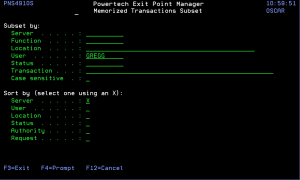How to Get There
On the Main Menu, select option 11. In the Work with Memorized Transactions panel, type F16.
What it Does
The Sort and Subset selections panel allows you to change which records are displayed on the prior panel, and in which order they are displayed. Selection is performed by making entries in the "Select by" section. Sorting is accomplished by specifying a sort order in the "Order by" section.
Field Descriptions
Subset by:
Server
A Server in Exit Point Manager is a controlled entry point into your system. These entry points are determined and defined by IBM. Exit Point Manager has assigned easy-to-remember names to these controlled entry points.
Function
A Function, or Server Function, in Exit Point Manager represents a class of operations that a given Server may perform. For example, the *SIGNON Server classifies its operations as those pertaining to changing passwords, generating authentication tokens, and retrieving signon information. Exit Point Manager has assigned easy-to-remember names to these Functions, such as CHGPWD, GENAUTTKN and RETRIEVE.
Location
Location represents the source of a transaction. Location can hold an IP Address, an IP Address Group or the name of an SNA Communications Device.
The special value *ALL, when used on a rule, means that the rule applies to any Location lacking a specific rule. When used as a subset or selection parameter, *ALL generally means to select all such rules for display or printing.
User
If the associated User Type is a 'U', User represents the identity of the person initiating a transaction as a user profile.
The special value *PUBLIC, when used on a rule, means that the rule applies to any User lacking a specific rule. When used as a subset or selection parameter, *PUBLIC means to select all such rules for display or printing.
If the associated User Type is a 'G', User represents a Exit Point Manager User Group.
Status
This is the status of the Memorized Transaction.
Possible values are:
Transaction
The Memorized Transaction against which incoming transactions are tested.
Undisplayable characters in the transaction data are replaced by the mid-dot character (·).
You can use the Transaction wildcard character (%) to make a Transaction generic. The wildcard character is valid only at the end of a Transaction string. When you are memorizing or changing a Memorized Transaction, the first occurrence of the wildcard character that was NOT present in the string before you changed it will make the string generic and all data after that wildcard character will be discarded.
Case sensitive
This controls whether the selection by transactions is case-sensitive. If left blank, 'N' is assumed.
Possible values are:
Sort by (select one using an X):
|
Server |
|
User |
| Location |
| Status |
|
Authority |
|
Request |
Command Keys
F3 (Exit): Exit the screen without processing any pending changes.
F4 (Prompt): Displays a list of possible values from which you may select one.
F5 (Refresh): Refreshes the screen and resets all available text fields.
F12 (Cancel): Exit the screen without processing any pending changes.
